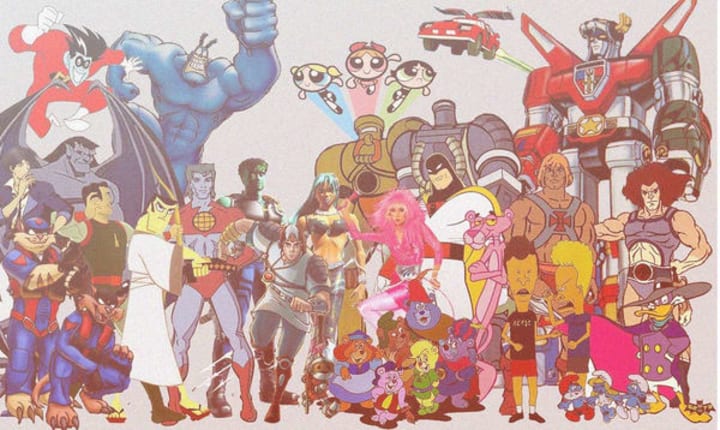How Japanese Anime Helped Your Favorite Western Cartoons Grow Up
These cartoons paved the way for studios like Disney, Warner Bros., Pixar and DreamWorks to get us to where we are now.

Coming of age is a rite of passage. It’s an inevitability, and while we may not always like it, ultimately every living thing in our world goes through a time of growth and evolution — even our beloved cartoons.
Yes, animation has changed over the years, and not just in regards to the quality of the art itself. I’m talking more along the lines of the inspiration behind these cartoons. Animation has been around for over 100 years, with the first American cartoons Colonel Heeza Liar and Gertie the Dinosaur having been released in 1913 and 1914, respectively. These simple cartoons paved the way for major studios like Disney, Warner Bros., Pixar and DreamWorks to get us to where we are now.
But there are just as many anime studios that brought us our beloved Saturday morning cartoon lineups.
Humble Beginnings

Hopefully you remember Saturday morning cartoons as fondly as I do.
So, what if I told you that most of your favorite current cartoons were actually influenced by anime? Would that surprise you? Well, the truth is that anime is one of the most influential elements of current Western cartoons. Some of you might say that just because there is anime playing in America, doesn’t mean it influences anything, but that’s not actually true.
Just look back at the Western cartoons that I mentioned earlier. SWAT Kats took the violence of anime that up until that point was unfamiliar to Western television in the mid-'90s. There's also Megas XLR, which takes the obvious styling of giant battle mechs from '80s anime and places one in New Jersey, but built from a muscle car.
And then of course Samurai Jack takes cues from anime outside of the fact that the titular character is a Samurai; the split screen/multiple-angle approach is similar to the classic 1963 anime Wanpaku Ōji no Orochi Taji,
I mean, shows like SWAT Kats: The Radical Squadron, The Pirates of Dark Water, Dexter’s Laboratory, Hey Arnold!, Johnny Bravo, Samurai Jack and possibly Megas XLR, they all had their own unique elements and established stories that we could get behind. And I think that's the really important takeaway.
To an extent, that generation of Western cartoons brought us the episodic story — that is, a string of episodes telling a complete narrative that reached an eventual climax. This idea is prevalent in almost every piece of anime. If you watched The Pirates of Dark Water, you'll remember that each episode built on the ones that came before it. In the show, we were introduced to Ren, a simple man who learns he's a prince and must travel the seas looking for treasure that can finally make him a true king (ahem, One Piece).
Brings you back, doesn’t it? All of these cartoons were geared toward Western (American) viewers. They were developed by US animation studios like Nickelodeon, Cartoon Network, Hanna-Barbara and Warner Bros., but they also looked to the artistic style of anime, which was prominent in Japan. The Western cartoons that I listed above have in particular their own distinct styles, but took certain nuances and themes from a variety of anime material, as well as countless other current anime like the Gundam series.
The Rise Of Anime In The West

Some of the most popular anime series ever, like Bleach, Naruto, Gundam, Pokémon, Dragon Ball Z and Sailor Moon, have gone a long way to help anime grow out of the stigma that it’s simply (as my wife has said) “cartoon porn” or pure violence. And while, to an extent, there are a few anime that carry that stigma, this animation style is much more than just those stilted stereotypes.
Anime in general focuses on more adult material and the various real-life concerns that arise in life: emotions, sexual themes, violence, relationships, and even the loss of life, hope, dreams — the list goes on.
When you consider how animation has evolved over the years, it's easy to see why it has risen in popularity. That acceptance has allowed Western cartoons to expand even further and develop new shows that aren't aimed just at kids.
Think about shows like South Park, Gravity Falls, Rick and Morty, and of course Adventure Time; all these shows have taken some of the elements of anime and adapted them. With these shows, it's about the subtle nuances, but the aesthetic appearance isn't the only way cartoons like these are being influenced.
The fictional world that we see in Adventure Time is remarkably similar to the worlds Satoshi Kon has created in anime like Perfect Blue, Paranoia Agent and Paprika. It's easy to see the similarities between these fanciful and mildly unnerving worlds and that of Adventure Time. Yet aspects of anime can be found in nearly any current Western cartoon, especially those that are geared toward the older generations of viewers.
The Future Of Cartoons

Animation is one of the most popular mediums for entertainment on the planet, and it’s not going anywhere. But it truly is a constantly evolving art form, as you can easily see when you look at the difference between Gertie the Dinosaur from 1914 and The Good Dinosaur from 2015. We’ve come a long way in 100 years!
A lot of that can be credited to advancement in cinema technology, but there’s still a lot to be said for the art itself. Anime has played a huge role in the advancement of animation in general.
It's easy to see how anime has advanced in Western animation and is carrying it into the future. Take a look at the adult animation and you’ll see the anime influences: the mature themes, the action and violence, and the overall artistic style. Shows like Archer, The Boondocks, The Venture Bros., Afro Samurai and BoJack Horseman all stray from the light-hearted Western cartoons and truly delve into darker territory, which is definitely a nod toward the influence of anime as a much grittier animation medium.
Whether or not you choose to watch anime doesn’t change the fact that it truly has made its impact known, and it will continue to influence modern Western animation for years to come. We may not see US cartoons that mimic shows like Kill la Kill or Attack on Titan, but the emotion and atmosphere is definitely something that will have a lasting impression on the West and the cartoons developed here.

About the Creator
Matthew Bailey
Husband. Father. Gamer. Cinema Lover. Mix it all together, and there I am. I love all things pop-culture and coffee; but coffee is the best.






Comments
There are no comments for this story
Be the first to respond and start the conversation.